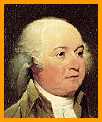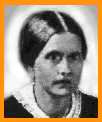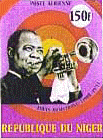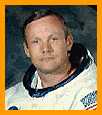
 |
| You might also like: | American History: W | American History: B | American History: R | American History: C | American History: L | Today's featured page: Hokusai: Wave Coloring Page |
| Our subscribers' grade-level estimate for this page: 4th - 5th |
US Flags |
EnchantedLearning.com US History |
US Geography |
| A | B | C | D | E | F | G | H | I | J | K | L | M | N | O | P | Q | R | S | T | U | V | W | X | Y | Z |
| African-Americans | Artists | Explorers of the US | Inventors | US Presidents | US Symbols | US States |
 Adams, John Adams, JohnJohn Adams (1735-1826) was the second President of the USA, serving from 1797 to 1801. His Vice-President was Thomas Jefferson. John Adams was born in Quincy, Massachusetts, on October 30, 1735. His father was a farmer. Adams graduated from Harvard University in 1755, and went on to become a lawyer in Boston. Adams was a delegate to both the First and Second Continental Congresses, and helped draft the Declaration of Independence. After the Revolution, in 1783, Adams went to France to sign the Treaty of Paris, and became the first US ambassador to Great Britain from 1785 to 1788 (this was a very difficult position, since the British were not pleased with the outcome of the war). Adams died on July 4, 1826, the 50th anniversary of the signing of the Declaration of Independence. Thomas Jefferson had died earlier that same day. |
 Adams, John Quincy Adams, John QuincyJohn Quincy Adams (July 11, 1767-February 23, 1848) was the sixth President of the USA, serving from 1825 to 1829. His Vice-President was John Calhoun. As President, Adams' political party was "National Republican." John Quincy Adams' father, John Adams, was the second president of the United States. John Quincy Adams was born in Quincy, Massachusetts, on July 11, 1767. Adams graduated from Harvard University in 1787, and went on to become a lawyer in Boston and was elected senator from Massachusetts in 1803. President James Madison appointed Adams Minister to the Netherlands and later, Russia. Adams helped negotiate the treaty that ended the War of 1812 (which was fought with Britain). Adams then became Madison's Secretary of State. He later negotiated the treaty with Canada that placed the border west of the Great Lakes at the 49th parallel. He then negotiated with Spain, obtaining a treaty that returned Florida to the USA. Adams also helped draft the Monroe Doctrine, that ended European colonization of the Americas. After winning the presidency in 1824 (beating Andrew Jackson), Adams' term included prosperity and road and canal building (including the Erie Canal, which connected New York City and the Great Lakes). Adams lost the next presidential election (Jackson won). Adams then served in the House of Representatives until his death (1831 until 1848). |
Alabama is a state in the southern United States of America. Its capital is Montgomery. Alabama was the 22nd state in the USA; it became a state on December 14, 1819. |
The Alamo is an old Spanish mission located in San Antonio, Texas. It was originally built to be the church for the Mission San Antonio de Valero, which was founded in 1718. The church was built by Spanish Franciscan friars in order to convert the local Indians to Christianity. The Alamo was the scene of a pivotal battle in the fight for the independence of Texas from Mexico. In the early 1800s, Texas belonged to Mexico. During the Texas war for independence from Mexico, Spanish troops occupied the abandoned building, now used as a fortress, calling it Alamo. The word álamo is Spanish for cottonwood (a type of tree that grows in the area). In 1836, Col. William B. Travis, James Bowie, Davy Crockett, and almost 200 other Texan volunteers occupied the Alamo. After unsuccessfully defending the Alamo for 13 days against an army of thousands of Mexican soldiers led by General Antonio López de Santa Anna, the Texans died on March 6, 1836. The phrase, "Remember the Alamo!" soon became the battlecry that was used by Sam Houston when he defeated Gen. Santa Anna a few weeks later at San Jacinto (on April 21, 1836), winning independence for Texas. Texas then became an independent republic (led by Sam Houston), and on December 29, 1845, Texas became a US state. |
Alaska is the 49th state of the United States of America. Its capital is Juneau. Alaska was the 49th state in the USA; it became a state on January 3, 1959. Alaska is the biggest state in the USA (656,425 square miles). |
| Aldrin, Edwin E., Jr. For a Buzz Aldrin coloring page, click here. |
| Alvarez, Luis Luis Alvarez (1911-1988) was a physicist who, with his son Walter Alvarez (a geologist), hypothesized that the a huge asteroid hit the Earth 65 million years ago, causing a mass extinction. The Alvarez Theory of Extinction is widely accepted. Luis Alvarez received a Nobel Prize in physics (1968) for his work on subatomic particles. |
The United States of America is a country in North America. There are 50 states in the United States of America. |
Roy Chapman Andrews (1884-1960) was a US fossil hunter and director of the American Museum of Natural History. Andrews led four expeditions to Mongolia's Gobi desert between 1922 and 1925. Many important finds were made on these expeditions, including Protoceratops bones and eggs (the first dinosaur eggs found!), and the new dinosaurs Oviraptor, Pinacosaurus, Saurornithoides, and Velociraptor. |
 Anthony, Susan B. Anthony, Susan B.Susan Brownell Anthony (1820-1906) campaigned against slavery in the USA and, after the Civil War, worked for women's rights, including the right to vote. She also fought for temperance (preventing people from drinking alcohol). Women were given the rigth to vote (the 19th Amendment to the Constitution) in 1920, fourteen years after her death. |
Johnny Appleseed (1774-1845) was a man who spread apple trees through the USA. His real name was John Chapman, but he was called Johnny Appleseed because of his love for growing apple trees. |
Arizona is a state in the southwestern United States of America. Its capital is Phoenix. Arizona was the 48th state in the USA; it became a state on February 14, 1912. |
Arkansas is a state in the United States of America. Its capital is Little Rock. Arkansas was the 25th state in the USA; it became a state on June 15, 1836. |
Armstrong, Louis  Daniel Louis Armstrong (August 4, 1901 - July 6, 1971) was a great jazz trumpet player, composer, and singer. He was nicknamed Satchmo because some people said that his mouth was like a satchel. Armstrong was born in New Orleans, Louisiana, and soon became a well-known cornet player in clubs and on riverboats along the Mississippi River. He became world famous for his incredible musical talent, especially his improvised solos. Armstrong also sang "scat," a style in which nonsense words are used in a song. Armstrong was featured in many recordings, television shows, and movies. Armstrong celebrated his birthday on July 4. Daniel Louis Armstrong (August 4, 1901 - July 6, 1971) was a great jazz trumpet player, composer, and singer. He was nicknamed Satchmo because some people said that his mouth was like a satchel. Armstrong was born in New Orleans, Louisiana, and soon became a well-known cornet player in clubs and on riverboats along the Mississippi River. He became world famous for his incredible musical talent, especially his improvised solos. Armstrong also sang "scat," a style in which nonsense words are used in a song. Armstrong was featured in many recordings, television shows, and movies. Armstrong celebrated his birthday on July 4. |
Armstrong, Neil Neil Alden Armstrong (August 5, 1930 - August 25, 2012) was the first person to walk on the moon. He piloted NASA's Apollo 11 mission, which took off on July 16, 1969. Armstrong and Edwin E. (Buzz) Aldrin, Jr., landed on the moon on July 20, 1969, in the lunar module (landing in the Mare Tranquillitatis), while Michael Collins orbited the moon in the command module. Upon his first step on the moon, Armstrong said, "One small step for man, one giant leap for mankind." Armstrong and Aldrin explored the Moon's surface for about 2 hours. Years earlier, in 1966, Armstrong and David R. Scott performed the first successful docking of two vehicles in space on the Gemini 8 mission. Neil Alden Armstrong (August 5, 1930 - August 25, 2012) was the first person to walk on the moon. He piloted NASA's Apollo 11 mission, which took off on July 16, 1969. Armstrong and Edwin E. (Buzz) Aldrin, Jr., landed on the moon on July 20, 1969, in the lunar module (landing in the Mare Tranquillitatis), while Michael Collins orbited the moon in the command module. Upon his first step on the moon, Armstrong said, "One small step for man, one giant leap for mankind." Armstrong and Aldrin explored the Moon's surface for about 2 hours. Years earlier, in 1966, Armstrong and David R. Scott performed the first successful docking of two vehicles in space on the Gemini 8 mission.For a Neil Armstrong coloring page, click here. |
| Attucks, Crispus Crispus Attucks (1723? - March 5, 1770) was the first American to die for the Revolutionary cause: "The first to defy, the first to die." Attucks was shot in the "Boston Massacre," the first fight leading up to the Revolutionary War. Attucks was the American son of a native African father and a woman belonging to the Natick Indian tribe. As a young adult, Attucks escaped his "owner" in Framingham, Massachusetts, and went to sea as a whaler and worked as a ropemaker in Boston, Massachusetts. He learned to read and write, and studied government. Attucks went to many anti-British meetings to discuss unfair taxes; he wrote to Governor Thomas Hutchinson (the Tory governor of Massachusetts) to protest these taxes. On March 5, 1770, Attucks and other Patriots (Colonists who were against British rule) fought with the Redcoats (British soldiers) at Dock Square in Boston in an unofficial skirmish. Attucks was the first of five people to die in the fight. The soldier who shot the Patriots were tried for murder, but most were acquitted (the future US President John Adams was the lawyer for the British soldiers); the acquittals further enraged the people of Boston. As the first person to die for the American Revolutionary cause, Attucks was buried with honor in the Park Street cemetery in Boston. "Crispus Attucks Day" was begun by black abolitionists in 1858; in 1888, the Crispus Attucks Monument was built in the Boston Common. |
Audubon, John James |
| Aviles, Pedro Menendez de |
| Ayllon, Lucas Vazquez de |
US Flags |
EnchantedLearning.com US History |
US Geography |
| A | B | C | D | E | F | G | H | I | J | K | L | M | N | O | P | Q | R | S | T | U | V | W | X | Y | Z |
| African-Americans | Artists | Explorers of the US | Inventors | US Presidents | US Symbols | US States |
Enchanted Learning®
Over 35,000 Web Pages
Sample Pages for Prospective Subscribers, or click below
|
Overview of Site What's New Enchanted Learning Home Monthly Activity Calendar Books to Print Site Index K-3 Crafts K-3 Themes Little Explorers Picture dictionary PreK/K Activities Rebus Rhymes Stories Writing Cloze Activities Essay Topics Newspaper Writing Activities Parts of Speech Fiction The Test of Time
|
Biology Animal Printouts Biology Label Printouts Biomes Birds Butterflies Dinosaurs Food Chain Human Anatomy Mammals Plants Rainforests Sharks Whales Physical Sciences: K-12 Astronomy The Earth Geology Hurricanes Landforms Oceans Tsunami Volcano |
Languages Dutch French German Italian Japanese (Romaji) Portuguese Spanish Swedish Geography/History Explorers Flags Geography Inventors US History Other Topics Art and Artists Calendars College Finder Crafts Graphic Organizers Label Me! Printouts Math Music Word Wheels |
Click to read our Privacy Policy
| Search the Enchanted Learning website for: |